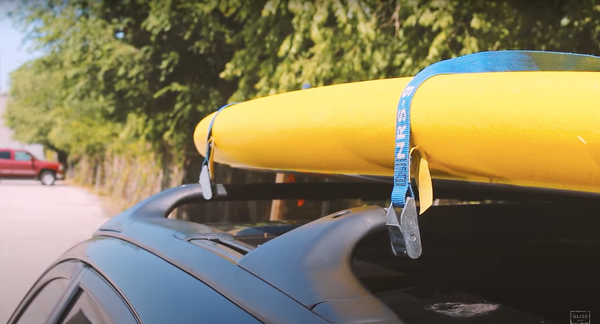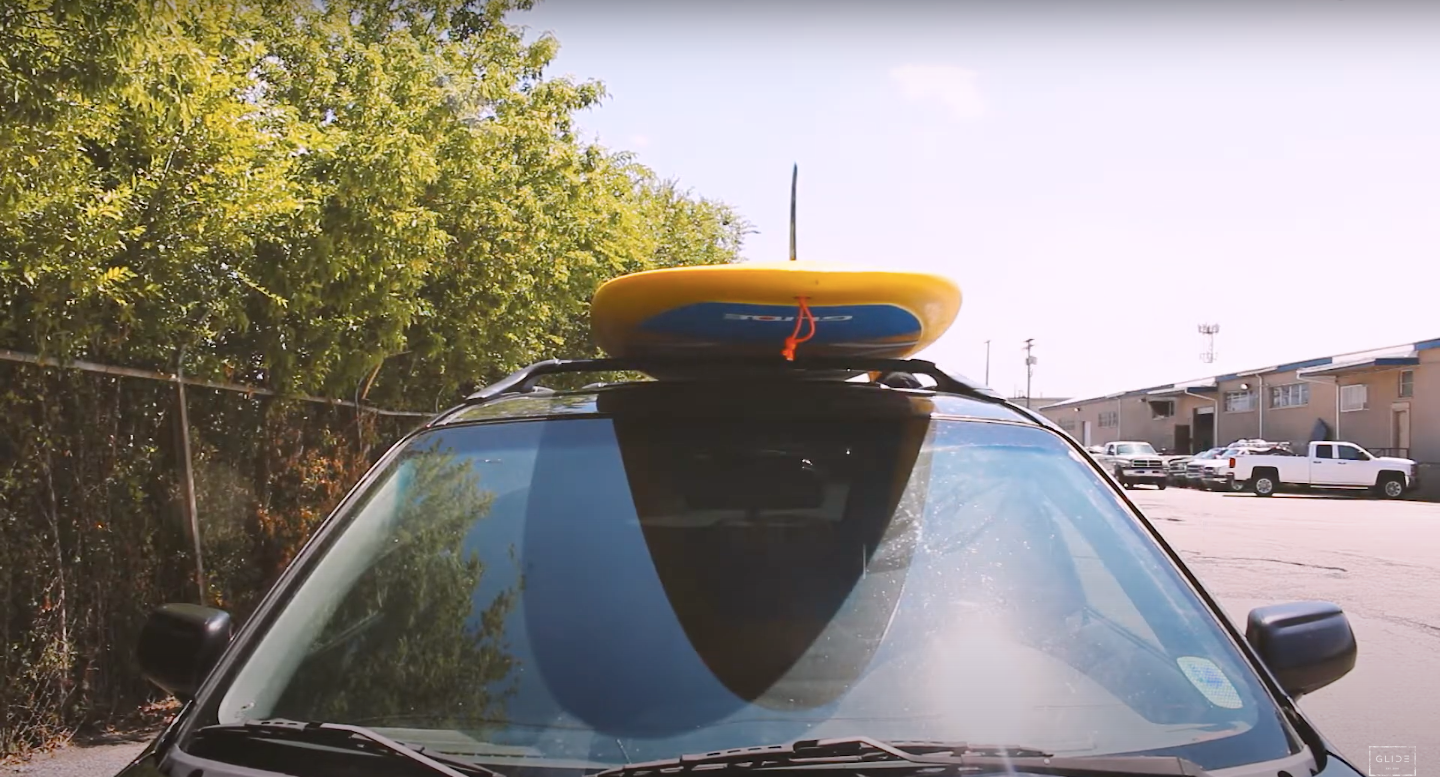
How to Strap a SUP to Your Roof Rack: Step-by-Step Guide (2025)
Strapping your SUP to a roof rack doesn’t have to be stressful. With the right gear and technique, you can safely transport your hard or inflatable paddle board anywhere. This guide covers supplies, steps, pro tips, and safety essentials for a smooth ride to your next adventure.
This guide walks paddlers through the complete process of strapping a SUP to a car roof rack safely and securely. It covers the essential gear you’ll need (roof rack, NRS straps, and your board), a clear step-by-step process for positioning and tightening, and expert tips to reduce strap noise and ensure roadside safety. It also explains quick removal techniques so you can get your board off the rack with ease. Whether transporting a hardboard or an inflatable SUP, this article provides practical, beginner-friendly advice to make sure your paddleboard arrives at the water intact and ready to ride.
Table of contents
Introduction
Transporting your paddle board safely is just as important as paddling itself. Whether you’re heading to a nearby lake or a coastal getaway, strapping your SUP (stand-up paddle board) correctly ensures your gear — and your car — stays safe. While inflatable SUPs can be packed in a backpack, sometimes it’s easier to strap them to your roof rack, especially if you’re keeping them inflated. Hard boards, of course, always ride on top.
In this guide, you’ll learn:
-
The essential gear for securing your SUP.
-
A step-by-step strapping method for beginners.
-
Pro tips for long-distance travel and noise reduction.
-
How to stack multiple boards.
-
Common mistakes to avoid.
-
FAQs for quick answers.
With the right technique, you’ll drive confidently knowing your paddle board is snug and safe.

Why Proper Transport Matters
Strapping your board down securely prevents more than just dings and scratches. Incorrect transport can:
-
Warp or dent your SUP rails.
-
Cause straps to loosen, creating dangerous situations for you and others on the road.
-
Reduce fuel efficiency if the board isn’t positioned correctly.
-
Lead to costly repairs or replacements if the board flies off.
A few extra minutes spent strapping properly means peace of mind all the way to the water.
Essential Supplies for Safe SUP Transport
Before you start, gather the right equipment:
-
Roof Rack: A solid, factory or aftermarket rack system is a must.
-
Straps: Use NRS 9’ cam straps (around $15 at REI or Amazon). These are secure, durable, and won’t damage your board. Avoid ratchet straps — they can over-tighten and crush your SUP.
-
SUP: Hard paddle boards or inflated inflatables can both be strapped to your rack.
👉 Pro Tip: Limit yourself to three boards max on one roof rack. Beyond that, stability decreases and strap tension becomes less reliable.

Step-by-Step: How to Strap a SUP to Your Roof Rack
1. Position Your Board
Balance the board on your head or shoulder with the handle aligned, then carefully lift it onto your roof rack. The deck pad should face down with the fins up and forward (to avoid wind drag).
2. Center the Board
From the rear of your car, slide and adjust the SUP until it’s evenly centered across the crossbars.
3. Arrange Your Straps
Stand on the passenger side for safety. Throw each strap over the board near the crossbars. Let the buckle hang on the side closest to you.
👉 Pro Tip: Keeping buckles on the passenger side makes it safer if you need to adjust straps on the shoulder of a road.
4. Secure the Straps
Loop the straps under the crossbar on the opposite side, then throw them back over to the buckle side. Feed the strap through the buckle and pull until snug — not crushing.
5. Eliminate Strap Noise
Twist the strap once or twice on top of the board before tightening. This prevents the annoying “strap hum” you’ll hear at highway speeds.
6. Final Check
Give your SUP a firm shake. If it shifts, tighten the straps further. Tuck away extra strap length inside the car door or tie it off.

Stacking Multiple Boards
Transporting two or three boards? Here’s how:
-
Place the largest/heaviest board on the bottom.
-
Use a towel or foam padding between boards to prevent scratches.
-
Run straps over all boards together, not individually.
-
Double-check strap tightness after driving a few miles.
For more than three boards, consider a small trailer or investing in soft racks for a second vehicle.
Alternative Transport Options
Not every paddler has a permanent roof rack. Fortunately, you still have options:
-
Soft Racks: Temporary pads with straps that loop through your car doors. Great for occasional use.
-
Inflatable Racks: Compact, travel-friendly racks that inflate and deflate as needed.
-
Backpack Transport: If you own an inflatable SUP, pack it down and carry it in the included travel bag instead of strapping it inflated.
Common Mistakes to Avoid
-
Over-tightening: Can crush the rails or leave pressure dents.
-
Using ratchet straps: Risk of damage and too much force.
-
Ignoring strap checks: Straps loosen after 20–30 minutes of driving; re-check before long trips.
-
Wrong orientation: Always place fins facing forward and up.
Long-Distance & Seasonal Tips
-
For highway driving, check straps every time you stop for gas.
-
On winter roads, salt and grit can damage your SUP. Use a board bag for extra protection.
-
On cross-country trips, consider investing in premium straps with built-in locks for security at rest stops.
-

Removing Your Board
Board removal is quick and simple:
-
Unbuckle straps on the passenger side.
-
Lift the board carefully off the rack.
-
Coil straps neatly and store them for next time.
Pro Tip: Always unload boards from the passenger side to avoid standing in traffic.
Conclusion
Learning how to strap a SUP to your roof rack is an essential skill for any paddler with a hard board — or an inflatable you want to keep pumped. With the right gear, the correct technique, and a little attention to detail, you’ll get to the water safely every time.
Whether you’re driving a few miles to your local lake or road-tripping cross-country, a properly secured SUP means one less thing to worry about.
Ready to roll? Pack your Glide SUP, grab your straps, and set out for your next paddle adventure with total confidence.
FAQs
Can I strap my inflatable SUP while it’s pumped up?
Yes, as long as it’s properly secured. However, many paddlers prefer deflating and packing it in the travel backpack for easier transport.
How tight should the straps be?
Snug but not crushing. Over-tightening can warp the rails or leave dents.
Can I stack multiple SUPs on my roof rack?
Yes, but stick to three boards maximum. Use padding between boards to avoid scratches.
What’s the best strap type for SUP transport?
NRS cam straps are the gold standard. Avoid ratchet straps.
Do I need a roof rack to transport my SUP?
Not always — soft racks and inflatable racks are affordable alternatives for cars without fixed systems.





